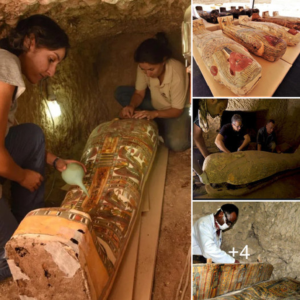In the sprawling tapestry of ancient Egyptian history, few artifacts evoke the regal splendor and cultural richness of the New Kingdom like the Rosette Head-dress belonging to a queen of Thutmose III. Dating back to the illustrious 18th Dynasty, circa 1479–1425 B.C., this exquisite adornment emerges as a symbol of both royal prestige and artistic mastery. Unearthed from the Tomb of the Three Foreign Wives of Thutmose III, Tomb 1, nestled in the ancient sands of Wady Gabbanat el-Qurud near Luxor, Egypt, this remarkable artifact now finds its sanctuary at the renowned Metropolitan Museum of Art, marked by accession number 26.8.117.
The Rosette Head-dress stands as a testament to the opulence and sophistication of the New Kingdom period, a time characterized by monumental achievements in art, architecture, and empire-building. Crafted with meticulous attention to detail, the head-dress bears witness to the skilled craftsmanship of ancient Egyptian artisans, who imbued every element with symbolic significance and divine beauty.

The association of the head-dress with a queen of Thutmose III, one of ancient Egypt’s most illustrious pharaohs, adds another layer of intrigue to its story. Thutmose III, often hailed as the “Napoleon of Egypt” for his military prowess and expansive conquests, presided over a golden age of Egyptian history marked by territorial expansion and cultural flourishing. As a queen of such a powerful ruler, the wearer of this head-dress would have been regarded with reverence and admiration, her adornment serving as a tangible expression of her royal status.

The significance of the Rosette Head-dress is further underscored by its provenance from the Tomb of the Three Foreign Wives of Thutmose III. This sacred burial site, located in the tranquil expanse of Wady Gabbanat el-Qurud, offers a window into the customs and rituals surrounding death and the afterlife in ancient Egypt. The presence of such a prestigious artifact within the tomb speaks to the importance placed on ensuring the comfort and status of the deceased in the journey to the realm of Osiris.

Now housed within the esteemed halls of the Met Museum, the Rosette Head-dress continues to captivate visitors with its timeless beauty and historical significance. As admirers gaze upon its delicate rosettes and intricate craftsmanship, they are transported back in time to an era of pharaonic grandeur and divine majesty. Through exhibitions and educational programs, the Met Museum endeavors to illuminate the cultural legacy of ancient Egypt, ensuring that artifacts like the Rosette Head-dress are preserved and celebrated for generations to come.
In conclusion, the Rosette Head-dress belonging to a queen of Thutmose III serves as a luminous beacon of Egypt’s rich cultural heritage and artistic ingenuity. From its origins in the New Kingdom to its current residence at the Met Museum, this extraordinary artifact continues to inspire awe and wonder, inviting us to explore the mysteries of ancient Egypt and the timeless allure of its royal splendor.





